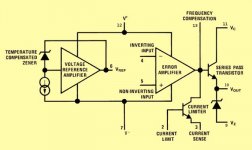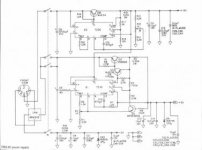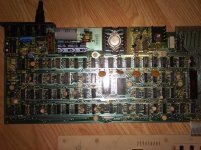The Vref (Pin 6) of Z1 (+5.0 VDC Regulator) should have the following VDC:
LM723
Reference Voltage 6.95=Min 7.15=Typical 7.35=Max
LM273C
Reference Voltage 6.80=Min 7.15=Typical 7.5=Max
The internal workings of the 14 Pin LM723C can be explained by dividing it into two blocks, the reference voltage generator and the error amplifier.
In the reference voltage generator, a zener diode is being compelled to operate at fixed point (so that zener output voltage is a fixed voltage)
by a constant current Source which comes along with an amplifier to generate a constant voltage of 7.15V at the Vref pin of the IC.
As for the error amplifier section, it consists of an error amplifier, a series pass transistor Q1 and a current limiting transistor. The error amplifier
can be used to compare the output voltage applied at Inverting input terminal through a feedback to the reference voltage Vref applied at the
Non-Inverting input terminal.These connections are not provided internally and so has to be externally provided in accordance with the required
output voltage. The conduction of the transistor Q1 is controlled by the error signal. It is this transistor that controls the output voltage.
Non Inverting Input
This is the non inverting input of the error amplifier whose output is connected to the series pass transistor. We usually give reference voltage
or a portion of it to the non inverting input.
Inverting Input
This is the inverting input of the error amplifier whose output is connected to the series pass transistor. We usually give output voltage or a portion
of it to the inverting input. This makes the output voltage constant.
Vref
It is the reference voltage output of the IC. It is the output of voltage reference amplifier. Its output voltage is about 7.15V.
Vout
It is the output terminal of the IC. Usually output voltage ranges from 2 to 37V. This pin can provide up to 150mA current.
Current Limit
It is the base input of the current limiter transistor. This pin is used for current limiting or current fold back applications.
Current Sense
This is the emitter of current limiting transistor. This terminal is used with current limiting and current fold-back applications.
Vc
This is the collector input of the series pass transistor. It is usually directly connected to the positive supply voltage if an external transistor is not used.
Freq. Comp
Frequency Compensation
This pin is used to connect a capacitor which bypasses high frequency noises. It is the output of error amplifier. The capacitor is connected between this
pin and inverting input of the error amplifier. The prescribed value of this capacitor varies for different types of regulators. Please refer the data sheet for that.
Vz
It is the anode of the zener diode whose cathode connected to the output terminal. It is usually used for making negative regulators.

Larry
REF:
https://electrosome.com/723-voltage-regulator/





